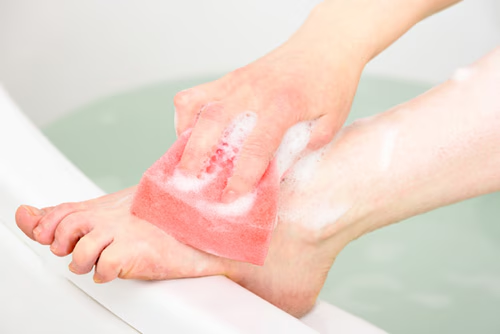Unlock the secrets to perfect insole trimming with our expert guide. Discover how tailored insoles can elevate your comfort and enhance shoe fit, ensuring every step you take is in harmony with your foot’s needs.

Introduction
Insole trimming stands as a pivotal customization technique, designed to tailor insoles for an impeccable fit within your chosen footwear. This guide delves into the art and science of insole trimming, offering invaluable insights for those seeking specialized support for various shoe types, including running shoes. Embrace the journey towards achieving the ultimate comfort and support through precise insole customization, ensuring your footwear complements every contour of your feet.
Table of Contents
Key Footwear Benefiting from Trimmed Insoles
Running and Athletic Shoes
Athletes stand to gain significantly from insoles that have been precisely trimmed. These insoles can boost performance and lessen the likelihood of sustaining injuries by providing better support and cushioning tailored to the demands of high-impact activities.
Typically, formal shoes offer minimal cushioning, making them less comfortable for prolonged wear. Inserting a custom-fitted insole can transform these shoes into a more comfortable option for extended periods of use, enhancing the overall experience.
Formal Shoes
Casual Shoes
The benefits of trimmed insoles extend to everyday footwear as well. For daily activities such as walking or shopping, insoles customized to fit casual shoes can greatly enhance comfort, making every step more enjoyable.
For individuals who spend extensive hours on their feet, the addition of trimmed insoles in work boots is a game-changer. These insoles deliver essential support and comfort, crucial for enduring long shifts without discomfort.
Work Boots
Hiking Boots
The rugged terrain encountered during hiking necessitates footwear that offers both stability and comfort. Custom insoles tailored to fit hiking boots can significantly improve the wearer’s stability and comfort, making long treks more enjoyable and less taxing on the feet.
Shoes designed with specific health conditions or specialized activities in mind also stand to benefit from the precise fit provided by trimmed insoles. These insoles can offer targeted support and comfort, addressing the unique needs of the wearer.
Specialty Footwear
Insole trimming is a valuable process for anyone looking to maximize the comfort and support of their footwear across a wide range of activities and shoe types. By ensuring a perfect fit, trimmed insoles can enhance the functionality of the shoe and improve the wearer’s overall foot health and comfort.
Tailoring Insole Support for Specific Foot Conditions
Customizing insoles through trimming can significantly enhance comfort and support for various foot conditions. Here’s a closer look at how tailored insoles can address and alleviate specific foot-related issues:
Support for Flat Feet
Individuals with flat feet often lack adequate arch support, leading to discomfort and pain. By precisely trimming insoles to fit their footwear, they can gain the essential arch support needed to reduce strain and discomfort, promoting a more natural foot alignment and improving overall foot health.
Relief from Plantar Fasciitis
Plantar fasciitis, characterized by sharp heel pain, requires insoles that provide substantial heel cushioning and arch support. Custom-fitting these insoles to the wearer’s shoes ensures that the critical areas of the heel and arch receive the support they need, helping to alleviate pain and facilitate healing.
Protective Cushioning for Diabetic Feet
Individuals with diabetes need insoles that help in minimizing pressure points to prevent sores or ulcers. Custom-trimmed insoles designed for even weight distribution across the foot can offer the protection needed, ensuring a safer and more comfortable walking experience.
Enhanced Comfort for High Arches
For those with high arches, insoles that offer additional cushioning and support directly beneath the arch are vital. Tailoring insoles to align perfectly with the foot’s arch ensures targeted support, reducing the risk of strain and injury by evenly distributing foot pressure during movement.
Stabilization for Overpronation
Overpronation, or excessive inward rolling of the foot, can lead to discomfort and imbalance. Insoles designed to provide stability and support, particularly around the inner foot, can correct this. Trimming these insoles for a precise fit enhances their effectiveness, aiding in proper foot alignment and reducing the impact on knees and hips.
Alleviating Pressure on Bunions and Hammertoes
Bunions and hammertoes can make finding comfortable footwear a challenge. Insoles trimmed to accommodate these specific conditions can significantly relieve pressure on the affected areas, making daily activities and walking more comfortable and less painful.
Comprehensive Guide to Custom-Fitting Your Insoles

Customizing your insoles through precise trimming can significantly enhance the comfort and support of your footwear. Here’s a detailed guide to ensure you achieve the perfect fit for your insoles, alongside tips to avoid common pitfalls during the process.
Step-by-Step Insole Trimming Process
Select the Appropriate Footwear: Begin by choosing the shoes that will house the new insoles. This ensures that the insoles are tailored to the specific pair you intend to wear.
Extract the Original Insoles: If your shoes come with manufacturer’s insoles, gently remove them. These will serve as your template for trimming the new insoles.
Align the Insoles for Sizing: Place the new insole on top of the original, aligning both pieces at the heel. This step is crucial for accurate measurement and sizing.
Trace the Outline: Using a pen, carefully trace the outline of the original insole onto the new one. Highlight any areas that require trimming to ensure a perfect fit within your shoe.
Verify Measurements Before Cutting: Before proceeding to cut, double-check your traced outline for accuracy. This precaution helps prevent unnecessary trimming and ensures the new insole matches the size of the original.
Proceed with Trimming: Utilize a pair of sharp scissors or a utility knife to cut along the marked lines. Aim for a smooth, clean cut to avoid jagged edges that could affect the fit and comfort.
Test the Fit: Insert the trimmed insole into your shoe to assess the fit. If adjustments are needed, carefully trim further until you achieve the desired fit.
Avoiding Common Trimming Mistakes

Inaccurate Measurements: Always use the shoe’s original insole as a benchmark for trimming. Miscalculations can lead to a poor fit, undermining comfort and potentially leading to foot issues.
Inappropriate Cutting Tools: Employ sharp, precise cutting tools for the best results. Dull instruments can result in uneven cuts, compromising the insole’s fit and function.
Excessive Trimming: Adopt a conservative approach, trimming gradually. Over-trimming is irreversible and can render the insole unusable for the intended shoe.
Overlooking Insole Thickness: Consider the thickness of your new insole, as it influences the overall shoe fit. Thicker insoles offer more cushioning but may reduce the available space inside the shoe, affecting comfort.
Compromising Arch Support: Take care not to alter sections of the insole that provide crucial arch support. Modifying these areas can significantly decrease the insole’s effectiveness and comfort.
Disregarding Shoe Type Variations: Be mindful that different types of shoes may require insoles of varying shapes and sizes. An insole fitted for athletic shoes may not be appropriate for formal footwear.
By following this guide and being mindful of common trimming errors, you can ensure your insoles provide the optimal balance of comfort, support, and fit for your specific footwear needs. Custom-fitting your insoles not only enhances foot health but also improves your overall experience with each step you take.
Maximizing the Benefits of Insole Trimming: A Detailed Guide
Customizing your insoles through careful trimming can transform your footwear experience, offering unparalleled comfort and support. Here’s an expanded guide on achieving the perfect fit, along with additional insights to ensure your insoles serve you well over time.

Precision Trimming Techniques
Start Conservatively: Begin by trimming slightly less than you think is necessary. Remember, you can always trim more if needed, but you cannot replace material once it’s been removed.
Consider the Material: Different insole materials may require specific tools for cutting. For example, denser materials might need a stronger cutting tool like a utility knife, whereas softer materials can be trimmed with scissors.
Follow Manufacturer’s Recommendations: Always check the manufacturer’s guidelines before trimming. Some insoles are designed with trim-to-fit lines or specific instructions to ensure optimal performance and durability after cutting.
Ensuring Insole Longevity
Routine Cleaning: Regularly clean your insoles to prevent the buildup of odor-causing bacteria and prolong their lifespan. Most insoles can be gently washed with a mild soap and air-dried.
Rotation Strategy: If feasible, alternate between different pairs of insoles. This rotation allows each pair to rest and recover, extending their useful life.
Proper Storage: When not in use, store your insoles in a cool, dry environment away from direct sunlight to prevent material degradation.
Advantages of Tailored Insoles

Unmatched Comfort: Custom-trimmed insoles are designed to fit your footwear flawlessly, significantly enhancing comfort for all-day wear.
Optimal Support: By fitting precisely in your shoes, these insoles provide targeted support to the arch, helping distribute foot pressure evenly and reducing overall foot fatigue.
Improved Fit for Your Shoes: Trimming insoles can make a loose-fitting shoe feel snug and secure, enhancing stability and reducing slippage.
Pain Relief and Injury Prevention: Tailored insoles can mitigate discomfort from common foot conditions like plantar fasciitis and contribute to injury prevention by improving foot alignment and stability.
Extended Footwear Durability: Well-fitting insoles can lessen the internal wear and tear of your shoes, potentially increasing their lifespan and saving you money in the long run.
FAQ Section
Q: Why is insole trimming important? A: Insole trimming ensures your insoles fit perfectly within your shoes, providing targeted support and comfort, crucial for preventing foot pain and enhancing shoe performance.
Q: Can all insoles be trimmed? A: Most insoles are designed to be trimmable, but it’s essential to check the manufacturer’s guidelines to ensure compatibility and avoid damaging the insole’s integrity.
Q: What tools do I need for insole trimming? A: Sharp scissors or a utility knife are recommended for clean, precise cuts. The choice of tool may depend on the insole’s material.
Q: How do I know if I’ve trimmed my insole correctly? A: A correctly trimmed insole should fit snugly within your shoe without curling up at the edges or shifting during movement. It should also align properly with the shoe’s original insole outline.
Conclusion
Mastering the technique of insole trimming can significantly impact your foot health and overall comfort. By following this comprehensive guide, you’re equipped with the knowledge to customize your insoles for an unparalleled fit, ensuring your footwear supports and enhances your daily activities. Remember, the goal of insole trimming is not just about achieving a perfect fit; it’s about fostering a harmonious relationship between your feet and your shoes, allowing you to walk, run, and stand with ease and comfort. Embrace the precision and care involved in insole trimming to unlock a new level of comfort and support for your feet.









Awesome issues here. I’m very happy to look your post.
Thanks so much and I am looking forward to touch
you. Will you kindly drop me a mail?
Appreciate the recommendation. Let me try it out.